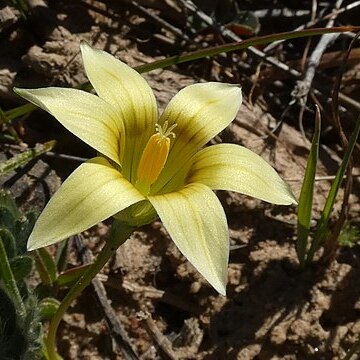Plants 100-300 mm long. Corm sub-globose or ovoid, with curved basal teeth bent over a rounded base. Stem short, hidden. Leaves 4-winged, ciliate on the wing margins or glabrous, 100-300 x 2-5 mm. Peduncles 40-200 mm long. Bracts greenish, sometimes submembranous towards the base, inner with wide membranous margins brownish towards the scarious tip. Flowers 18-35 mm long, pale yellow, often with a pale reddish brown or greenish brown transverse zone above the throat. Perianth tube 4-5 mm long; segments 12-25 x 4-8 mm. Filaments 5-6 mm; anthers 3-5 mm long, golden-yellow. Style 8-14 mm; stigmas reaching halfway up the anthers or almost to their tips. Capsules subglobose or ellipsoid, on suberect or slightly bent peduncles.
Cormous geophyte, 50-150 mm tall, corms rounded at base with curved acuminate teeth. Leaves several, 4-winged (H-shaped in cross section), wing edges hairy. Flowers pale yellow, sometimes with brownish markings; bracts green, outer with narrow, usually brown-spotted, hyaline margins, inner with dry brownish margins; fruiting peduncles recurved or suberect.
Cormous geophyte, 5-10 cm, corms rounded at base with coarse, bent teeth. Leaves several, H-shaped in section, 4-winged, wings ciliate to hairy. Flowers dull yellow.

